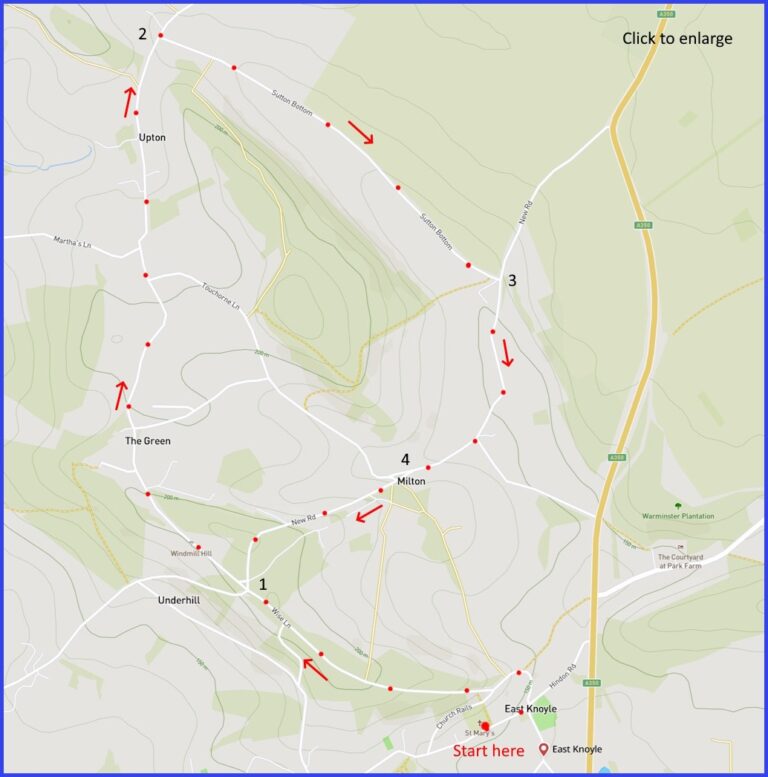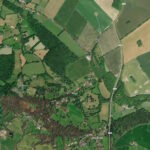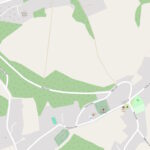A 4-mile, easy and charming walk. Entirely on lanes. Very quiet – but still take care in case of occasional vehicle. Click here for an aerial view. Click here for a downloadable PDF of guide. (There is a GPX route option here for phone/tablet download. But only follow this link after watching this GPX help video).
(Routes suggested from each map point + metres to next point)
Start: Walk eastwards from the church to junction (‘Wren’s Shop’ on right). Head left and up Wise Lane. Stay on lane, veering right at blue “unsuitable…” road sign. (Dean Wren made a steps shortcut to this point from just beyond church, safe but steep.) Continue to point… [1.2km]
1: Passing ‘Clouds House’ sign and New Road Junction. Continue through The Green and Upton until… [1.7km]
2: Take a right turn (signed “Milton”) onto Sutton Bottom. Continue until… [1.1km]
3: Junction for turning onto right route (signed “East Knoyle”). Continue through Milton, on slight incline until fork at… [650m]
4: Take upper path past phone box until returning to [550m]
1: Retrace steps along Wise Lane to Start [1.1km]
The pictures below are in the order things were seen on this walk. Clicking on any one will enlarge it (and the slideshow)
The walk
An easy walk on lanes and quiet country roads. From the birthplace village of Sir Christopher Wren you walk up to some fine views, and then pass through several attractive Wiltshire hamlets, all with a scattering of 18th and 19th century dwellings. The roads have little traffic – for instance, between points 1 and 3 on the map we didn’t encounter a single vehicle. There are some impressive mediaeval dwellings in East Knoyle and an exceptional Victorian mansion (‘Clouds House’) just beyond.
The place: Knoyle village
In East Knoyle you can’t avoid being reminded that this is the birthplace of Christopher Wren. Possibly the village over-eggs this fact. Because although Wren was born there (1632) – along with his three sisters – it was only during his first eight years that he might have spent significant time at East Knoyle. In fact, he may even have spent stretches of that early period in London (ultimately at Westminster School), because his father was appointed to the Dean of Windsor in 1635. On the other hand, the prosperity of the Wren family owes something to Wiltshire. Wren senior married Mary Cox of Fonthill Abbey who was the sole heir within a wealthy family. (Sadly, she died two years after her son’s birth.)
The village has a community website. While a bit light on news it does have useful links to local services and a gallery of photographs. However, there is another site that offers a detailed account of village history. Perhaps more than you could possibly want. Its based on scholarly interrogation of a large body of surviving documentary evidence of village life – particularly local news sources. For instance, you can learn that in 1731 “in the parish of East Knoyle…one Richard Small, a Servant to Farmer Williams of that place, eat 85 Eggs fry’d with 3 Pounds of Bacon, and drank 3 quarts of stale Beer” or that in 1760 “Joseph Brown, a Shepherd, at East Knoyle, died of the bite of a mad dog”. And there is much more.
The place: church
It turns out that the Rector of East Knoyle, Christopher Wren Senior, was himself something of an architect. So we know that he designed a building for the queen consort of Charles I, and that he also drew up designs for the roof of his own church. However, more famous is his work on the decoration of the chancel walls in that church. Pevsner declares “the chancel ought to be the purpose of a visit from every Wiltshire tourist” (you have been told). St Mary’s church is well described here – including an explanation for why this chancel is so distinguished.
Briefly, Wren’s father designed and commissioned an elaborate plaster motif on the walls of the chancel [B] – for the traditional purpose of more vividly explaining to parishioners various New and Old Testament stories. If you enter you can enjoy it today. Slightly restored of course because, unfortunately, the resulting Biblical imagery did not impress Cromwellian tastes at that time. Hence a group of marauding Roundhead soldiers broke in and knocked the heads off Wren’s ‘idolatrous’ plaster figures. Being a strict Royalist, Christopher Wren Senior got into trouble later for his unfashionable views: at his trial the example of the controversial plasterwork was cited against him. All of which led to a £40 fine and a loss of his living at the East Knoyle church.
There are two impressive mediaeval buildings to the west of the church – one of which has been converted into a village hall (and where you may find convenient parking if you visit by car).
The place: Windmill
Beyond Point 1 on the map you will notice to your right an apparently decapitated windmill [F]. That is just what it is: built in the 18th century for the grinding of barley. Sadly, the sails of this windmill were lost in a fire – brought about in 1911 by fireworks celebrating the Coronation of George V. So, Lord Wyndham (owner of the surrounding estate) converted it into a summer house with artist’s studio. Perhaps thinking of the fine views of Wiltshire and beyond (that you can enjoy at this point of the walk). Anticipation of those views is possible from this video – although it’s giddy flight makes for a rather sluggish panorama. Beyond this point you could take advantage of refreshment at the Fox and Hounds pub [G]
The place: Clouds House
At Point 1 on the map you will see to the right a sign directing to ‘Clouds House’ [E]. It is worth a short detour to get a closer look at this substantial Victorian dwelling (Pevsner says: “one of the most important houses of the late C19”). A substantial house had existed on this estate for a long period (particularly for the Wiltshire Seymours) but its present form dates from 1883 and ownership by the aristocratic Wyndham family. Unfortunately, that building was destroyed by a winter fire in 1889 – snow and ice ironically impeding efforts to extinguish it. But immediately after, insurance allowed it to be rebuilt – in the arts and crafts style. Mrs. Madeline Wyndham drawing upon William Morris and Burne-Jones for patterns and paintings inside. Since then the building has been re-modelled somewhat, including some Georgianisation in the 1930s. It is hard to get a close view of how it is now without acting intrusively, but this flyover drone video gives a very good sense of both the exterior and interior.
While it was owned by the Wyndham’s the house become a meeting place for influential cultural and political figures (Percy Wyndham was a Tory MP) – often in the shape of The Souls (see also the house at Easton Grey in Wiltshire). The Wyndham family gradually sold off the property and it thereafter became a secretarial college and then a Church home for unwanted babies. It is now a rehabilitation centre for addiction and dependency. A sense of what goes on there is conveyed by this video, in which the Duchess of Cambridge makes a virtual visit to talk about their work.
This Clouds House story (and much more about the area) can be found in Caroline Daker’s book ‘Clouds: Biography of a Country House’.




![[A]](https://wiltshirewalks.com/wp-content/uploads/2023/11/eastknoyle_01-150x150.jpg)
![[B]](https://wiltshirewalks.com/wp-content/uploads/2023/11/eastknoyle_02-150x150.jpg)
![[C]](https://wiltshirewalks.com/wp-content/uploads/2023/11/eastknoyle_03-150x150.jpg)
![[D]](https://wiltshirewalks.com/wp-content/uploads/2023/11/eastknoyle_04-150x150.jpg)
![[E]](https://wiltshirewalks.com/wp-content/uploads/2023/11/eastknoyle_05-150x150.jpg)
![[F]](https://wiltshirewalks.com/wp-content/uploads/2023/11/eastknoyle_06-150x150.jpg)
![[G]](https://wiltshirewalks.com/wp-content/uploads/2023/11/eastknoyle_07-150x150.jpg)
![[H]](https://wiltshirewalks.com/wp-content/uploads/2023/11/eastknoyle_08-150x150.jpg)
![[I]](https://wiltshirewalks.com/wp-content/uploads/2023/11/eastknoyle_09-150x150.jpg)
![[J]](https://wiltshirewalks.com/wp-content/uploads/2023/11/eastknoyle_10-150x150.jpg)